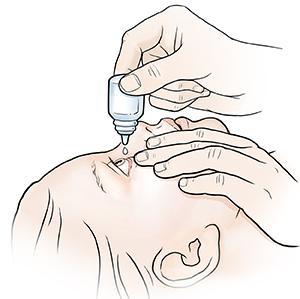The conjunctiva is a thin membrane in the eye. It covers the white of the eye and the inside of the eyelid. A very small object, such as an eyelash or dirt, sand, grit, or cosmetics can become trapped under the eyelid. This is called a conjunctival foreign body. This can be very irritating to the eye, no matter how small the object is.
Your child may feel a lot of pain in the eye. The eye and the eyelid may become red and swollen. The object in the eye might also cause excessive watering of the eye, blinking, and pain while looking at light (photophobia). It can become hard for the child to open the eye or even to sleep.
A topical anesthetic may be put in your child’s eye. This soothes pain. It also helps the health care provider look at the eye and remove the object.
Home care
Your child’s health care provider may prescribe eye drops or an ointment. These are to help ease pain and prevent infection. Follow all instructions when using these medicines.
To give your child eye medicine
-
Wash your hands well with soap and clean, running water. This is to help prevent infection.
-
Remove any drainage from your child’s eye with a clean tissue. Wipe from the nose toward the ear. This is to keep the eye as clean as possible.
-
To remove eye crusts, wet a washcloth with warm water and place it over the eye. Wait for 1 minute. Gently wipe the eye from the nose outward with the washcloth. Do this until the eye is clear. If both eyes need cleaning, use a separate cloth for each eye.
-
Have your child lie down on a flat surface. A rolled-up towel or pillow may be placed under the neck so that the head is tilted back. Gently hold your child’s head, if needed.
-
Using eye drops: Apply drops in the corner of the eye, where the eyelid meets the nose. The drops will pool in this area. When your child blinks or opens their lids, the drops will flow into the eye. Give the exact number of drops prescribed. Be careful not to touch the eye or eyelashes with the dropper. Do not touch the dropper tip. Bacteria from your fingers might get on the tip and contaminate it.
-
Using ointment: If both drops and ointment are prescribed, give the drops first. Wait 3 minutes, and then apply the ointment. Doing this will give each medicine time to work. To apply the ointment, start by gently pulling down the lower lid. Place a thin line of ointment along the inside of the lid. Begin at the nose and move outward. Close the lid. Wipe away excess medicine from the nose outward. This is to keep the eye as clean as possible. Have your child keep the eye closed for 1 or 2 minutes so the medicine has time to coat the eye. Eye ointment may cause blurry vision. This is normal. Apply ointment right before your child goes to sleep. In infants, the ointment may be easier to apply while your child is sleeping.
General care
-
Wash your hands well with soap and clean, running water before and after caring for your child’s eye.
-
Gently wipe eye crusts away with a clean, warm, damp washcloth. Wipe from the nose toward the ear. This is to keep the eye as clean as possible.
-
Make sure your child doesn’t rub their eyes.
-
Trim your child’s nails weekly to prevent eye scratches.
-
Don’t let your child wear contact lenses until all the symptoms are gone.
-
Don't try to remove any object that is stuck in the eye.
Follow-up care
Follow up with your child’s health care provider as advised.
When to get medical advice
For a usually healthy child, contact the health care provider right away if any of these occur:
-
You can see a small particle in your child's eye, but it's not coming out.
-
Symptoms don’t get better, or they get worse.
-
Your child has vision changes, such as trouble seeing.
-
Your infant can't follow movement with eyes.
-
Your child has signs of infection, such as warmth, redness, swelling, or fluid leaking from the eye.
-
Your child’s pain gets worse. Babies may show pain as crying or fussing that can’t be soothed.
-
Your child is unable to keep their eye open after a few days of treatment.
Call 911
Call
Featured in
Author: Wheeler, Brooke
© 2000-2025 The StayWell Company, LLC. All rights reserved. This information is not intended as a substitute for professional medical care. Always follow your healthcare professional's instructions.

